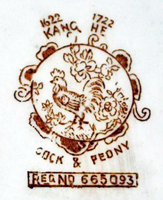
COCK & PEONY
Carlton Ware's COCK & PEONY pattern and its Border
by Harvey Pettitwith border artwork by Barbara Anne Lee
Whilst studying Chinese ceramics at Art School, Horace Wain, Carlton Ware's designer and decorating manager, (roughly between 1913-1922), will have seen many illustrations of Oriental porcelains. In the early 1900s, several authoritative tomes were published about old and esteemed Chinese pottery, testament to how en vogue Chinese designs had become at that time. Indeed, around the turn of the century, the term “Chinamania” was used to describe their popularity.
The rooster or cockerel is an honoured creature in China and is the tenth sign of the Chinese zodiac much portrayed on Oriental porcelain and consequently replicated by Wain. Aside from seeing illustrations of such portrayals, Wain may also have seen examples in local private collections or perhaps in the local Hanley Museum or even at the Victoria and Albert Museum in South Kensington in London, which, in 1909, had been bequeathed a large collection of Chinese antiquities which once catalogued was placed on display in 1911.
Fowl Play
Enter Horace Wain's COCK & PEONY pattern for Carlton Ware. Below left,
I show a Chinese export porcelain plate from around 1730. Wain's interpretation of the fowl has a similar composition as you can best see on the adjacent plaque with the POWDER BLUE ground.

Right - Two examples of Horace Wain's interpretation of the Chinese pattern for Carlton Ware c.1918.
Click or tap on the image above to enlarge.
To return to this page use your back button.
Like many of Wain's patterns, COCK & PEONY has right and left hand versions so that matched pairs could be made. On one, the birds face right, on the other, the birds face left. Carlton Ware's pattern records list twenty variants so the pattern must have been in demand. Examples with CLOISONNE WARE and ARMAND LUSTRE backstamps have surfaced.

Wain was fond of introducing special backstamps. Sometimes examples of Carlton Ware's COCK & PEONY are found with the backstamp shown right.
It is a vignette of the pattern encircled by curlicues and "clouds" or "smoke" in a Chinese style. The backstamp tells us that the pattern was part of Carlton Ware's KANG HSI range (though spelt Kang He). It also tells us that the pattern was registered as a design in 1918, though its pattern number suggests that it was introduced somewhat earlier, either just before, or during World War One. As I mention in another article in this series, this later date is probably down to the war having curtailed and delayed many Civil Service and Government tasks as so many administrators were called up to fight in the War.

I write this on a day of the total eclipse of the sun. I read that some who view the totality take a rooster with them to hear it crow as sunlight returns. Is it fanciful to suggest that Wain's irregular decoration around the circle enclosing the cockerel and flower represents the eclipse at totality when the corona and loops of plasma rising from the sun's surface become visible?
The more I look at the mark, the more I am convinced that I could be right. Wain could be playful with his work (so can I!).
The COCK & PEONY border
Barb has cleverly redrawn the COCK & PEONY border as below.
Similar borders are found on Chinese ceramics.

© Barbara Anne Lee 2023.
Below, Barb shows us how the border looks on different grounds.
 © Barbara Anne Lee 2023
© Barbara Anne Lee 2023 Occasionally, a sheet pattern, (so called because it was printed as a sheet rather than a border) was cut into strips and used as a border. You can see a strip of a sheet pattern used on the inside of the rim on the yellow vase above.
Harvey.
V2. Revised Aug 2024
Barb would like to thank Chris Meallin, for supplying good quality images to enable her replicate the borders above.
The next pattern in the sequence of Horace Wain's Chinoiserie patterns with an associated border is MIKADO.
NOTE - To help you avoid mixing up pattern and shape names I use some simple typographic conventions. You can read them by clicking or tapping on the button on the left below.
Or